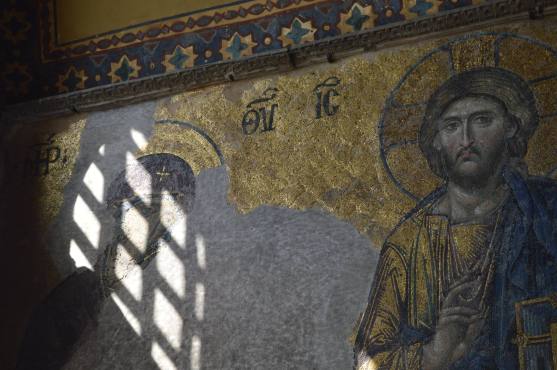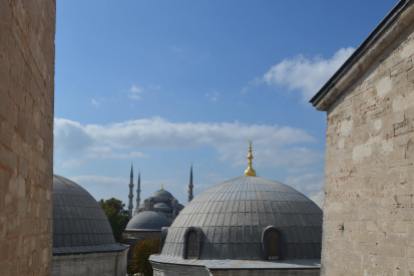
Mosque Monday is a month-long series through Ramadan where I am sharing some of the beautiful mosques that I have visited.
Istanbul is a city that has a very special place in my core. It is not only because it was one of the stops that my husband and I visited on our wonderful honeymoon a little over 5 years ago, although that certainly does help with my deep romance with the city. But more than that, there is something near mystic about Istanbul that burrows into your soul when you spend any time in its splendor. Napoleon once said, “If the Earth were a single state, Istanbul would be its capital.” And to my mind, if Istanbul were a single person, the Hagia Sophia would be its heart.


There are so many beautiful sites in Istanbul, and I visited several mosques in my short 36 hours in the city that are gorgeous and rife with reasons to urge you to visit – some may be even more posh to share as “hidden gems” – but despite all of that, if you were to visit Istanbul an not visit the Hagia Sophia, it would be a true crime. For this reason, and because of its wealth of history and its unique cross-religion beauty (largely due to some of the darkness in its history) it has won out to be shared with you tonight.


The Hagia Sophia was built in 537 AD, which means that it is almost 1500 years old (I hope to get back there before then, but I have just put a reminder on my calendar to visit in 2037 so that I can celebrate her 1500th birthday with this gorgeous piece of history). The Hagia Sophia was originally constructed and lived the first 900 years of her life as an Eastern Orthodox cathedral, aside from a 57 year blip after the Fourth Crusade where it operated as a Roman Catholic cathedral. In 1453, Istanbul (then Constantinople) was conquered by the Ottoman Empire and thus the cathedral became a mosque.


The transition from religion to religion has created a beautiful masterpiece that now speaks to the tolerance of modern-day Turkey. Although Turkey proudly enjoys its Muslim government, its 1982 constitution established it as a secular state that prohibits religious discrimination. The Hagia Sophia stands as an impressive example of the appreciation an acceptance of religious difference. In every corner of her beauty, the layers of her experience lay bare, showcasing the mutuality of a reverence for God between all those that have utilized her walls as a conduit to the Holy.

Now, this beautiful blend of religion is not without its controversy. The Hagia Sophia currently operates as a museum, as it as for more than 80 years. In its function as a museum, it is open to all and does not actively function as mosque. For many years, there has been a push among more conservative Muslims to reconvert the Hagia Sophia into an active mosque. This desire gained even more steam in the past several years, following President Trump’s controversial decision for the United States to recognize Jerusalem as the capital of Israel (as opposed to Tel Aviv, which most other countries utilize for their embassies in an effort to remain neutral in view of the ongoing Israeli-Palestinian conflict).

In addition to her interesting religious history, the Hagia Sophia is also exceptional in her size. While impressive from the outside, it is the view from within the cathedral-made-mosque that creates a near-transcendental experience. The doors alone seem impossible in their scale.





Juxtaposed against the impressive nature of the grandness of the structure of the mosque is the very fine details throughout the building. In every direction there is a new stunning facet to discover.
One of my favorite features of the Hagia Sophia is the chandeliers. Chandeliers are beautiful feature in many mosques around the world (even the more recently built mosques, as described in my Mosque Monday post about the Grand Mosque in Abu Dhabi). Chandeliers are likewise a feature of cathedrals throughout the ages. The fixtures are impressive, but the former waitress in me feels deeply for the candle lighters through the ages!
Finally, the view from within the Hagia Sophia is not to be missed. As I mentioned at the outset, beautiful mosques are abound within Istanbul, and it is not a surprise that another iconic mosque, the Sultan Ahmed Mosque (more commonly known as the Blue Mosque) can be viewed through her ancient windows.
All in all, the Hagia Sophia is a site that is not to be missed. Check back in next Monday for a look at another gorgeous mosque. Till then, Ciao Ciao, Darling!













